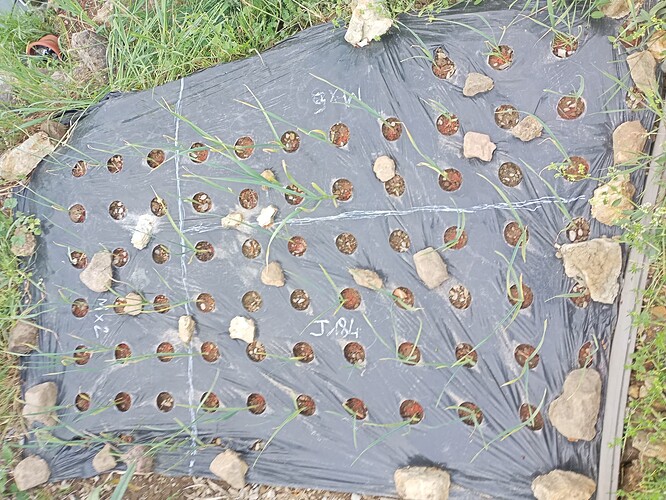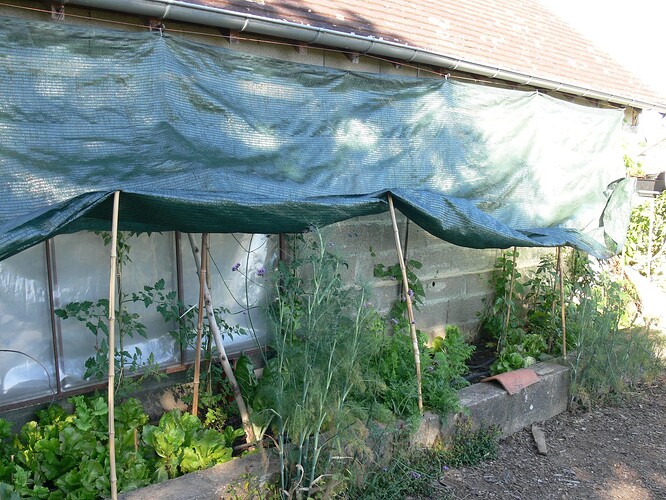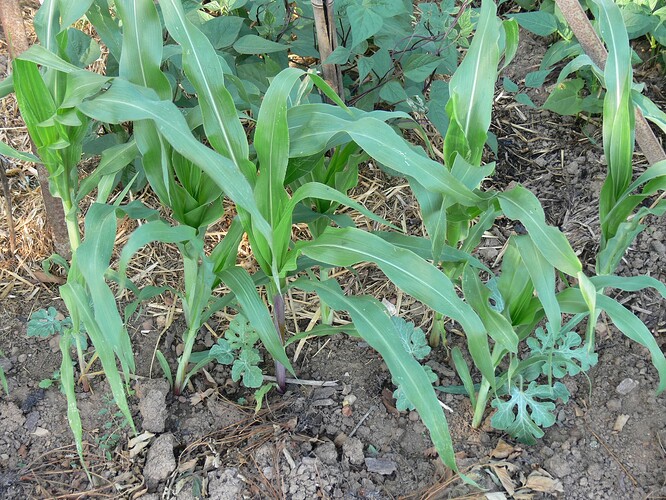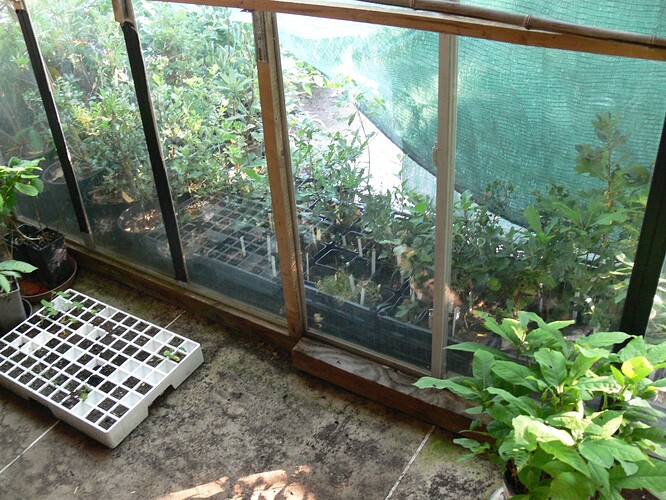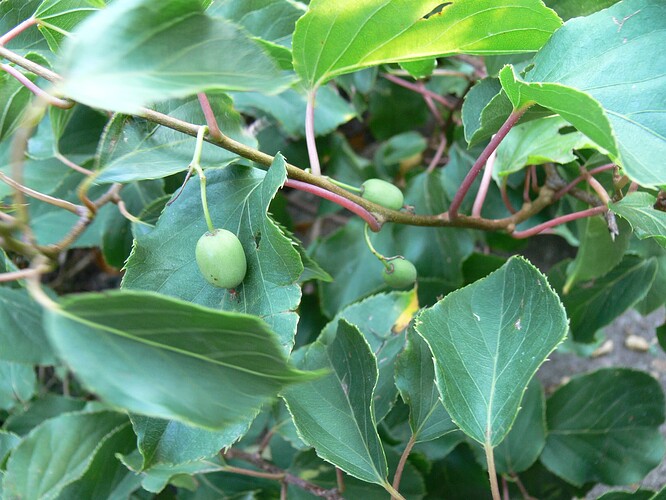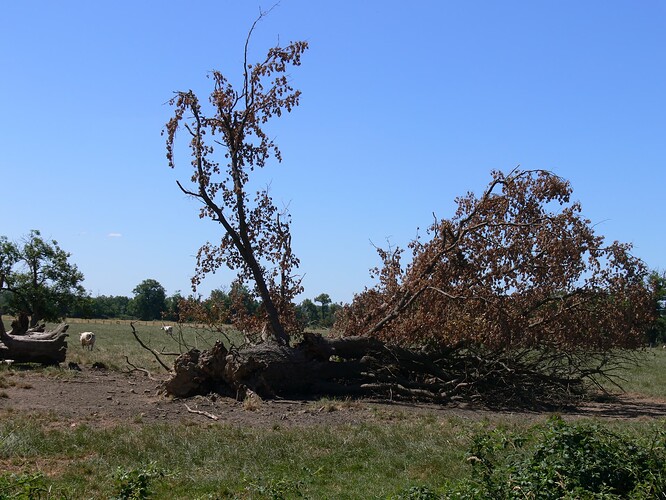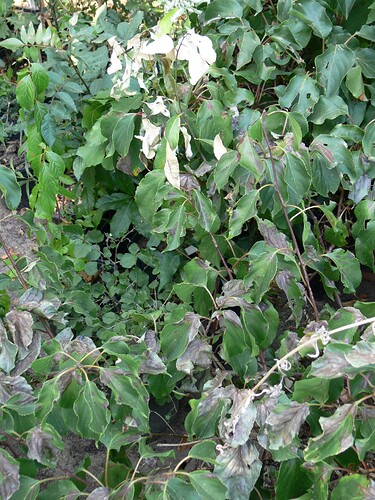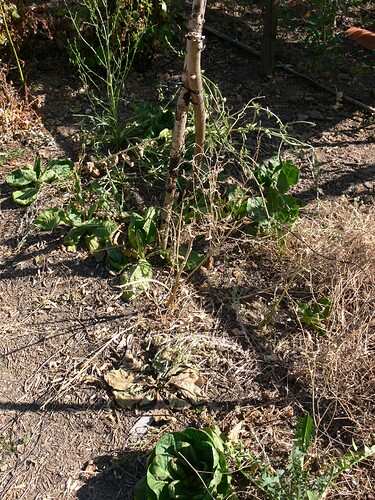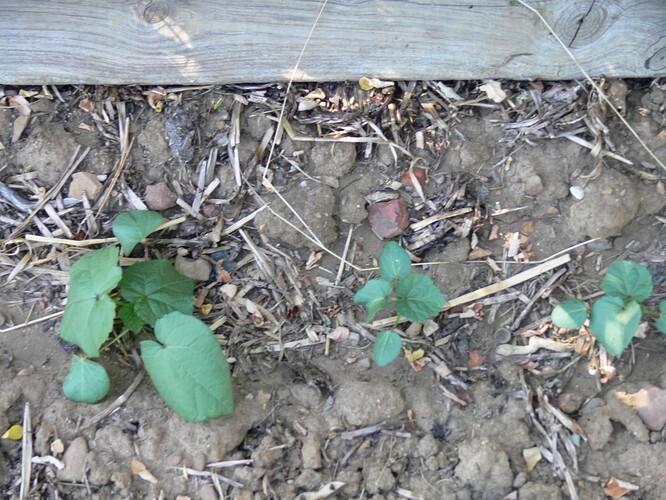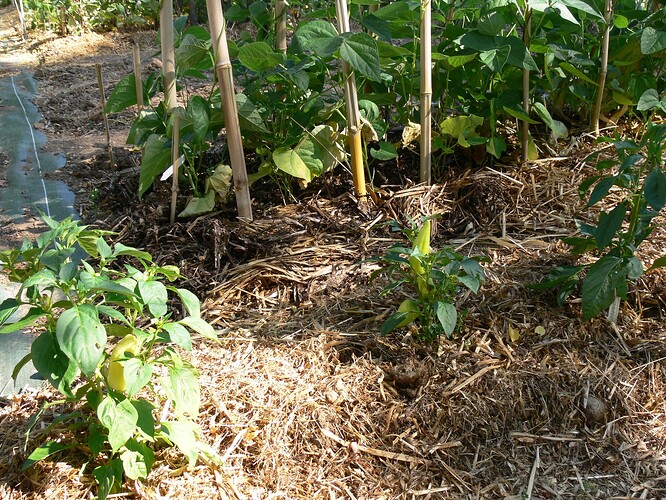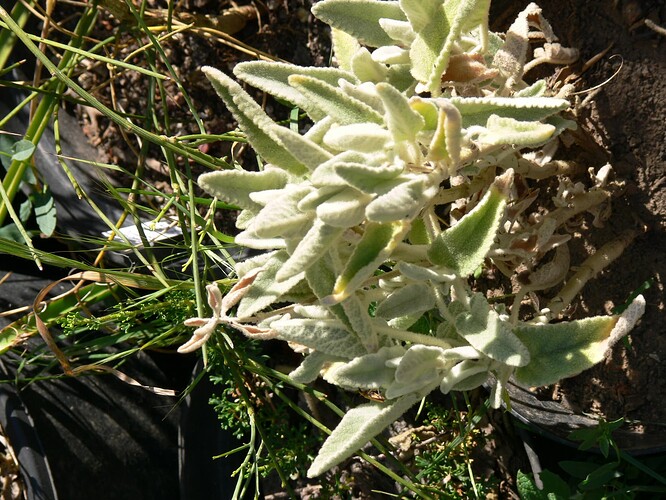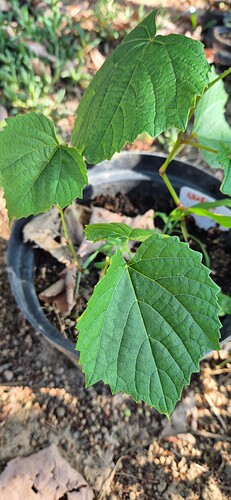I used to do that allllll the thyme when I was breeding Cannabis plants with favorable traits but maybe odd pollen timings or maybe I didn’t have the focused attention in the push to Flower.Say, I wanted a cross of a Sour with an OG the following season but I wanted more
Indica stacks as opposed to the stepping cloud nuggets of a Lemon OG? I’d freeze a Sour 78 pollen bag and bring it back out the following season to start isolating cross clusters. It definitely works. I imagine corn pollen freezing (or any other plant, honestly) is very worth trying this with. Awesome thoughts here!
I never did, but it seems that freezing pollen can work with any plant… ![]() this is also used in insemmination centers for animals too…
this is also used in insemmination centers for animals too…
So let’s try this to save this corn from a climate so far away that may have no chance of self-fertilizing here with a too short growing season.
The plants are still in the pot greenhouse, I plan to take them out at the end of next week to plant them against a wall to the south in order to accelerate them.
Soon pollen exchanges on Going to seed? ![]()
Hi Stéphane,
… sorry for the delay in replying…
Yes, these garlics aren’t very vigorous.
Some more than others…
But in our defense, we asked for them and planted them late.
Planted in the fall, I think things would have been different!
I took photos when you contacted me, and I never replied, sorry! ![]()
![]()
Since then, things have improved for a while, after a dose of fertilizer, then rust struck…
Some won’t even flower and have their stems lying flat against the ground…
But Alliums are often surprising in their speed of bulbification, so I’m not giving up hope until I’ve dug them out of the ground.
For comparison, the largest are Chesnok Reds planted in autumn.
The weather here is very hot and dry
like cows, we sit still and wait for 9 p.m. to start living again in the evening.
fortunately, the main spring not far from the house still flows for drinking water… but also for watering the garden with about 1000L every 4 days.
This year is therefore the year of verticality in the garden, to create as much shade as possible on the ground and cut out the hot wind.
daikon grex in seed ready to collect.
grex of peas that burns in the sun… burn, burn, yes I gotta burn ! (Rage Against The Machine spirit
radish grex which follows the same path…fava beans for seeds which unfortunately only bear 5 seeds
the leeks are in full bloom! the best plants were put all together in the same hole in May… little watering but good fruiting with lots of insects.
a few chicory flowers for the future grex project
a few parsnips in bloom, as tall and beautiful as ever
the small harvest of TGS
I was able to save the bulbs by the skin of my teeth:
AS01131 1 bulb
AX4XJ203 1 bulb
AS0156 3 bulb
AS0151 6 bulb
AS0153 7 bulb
AS0152 20 bulb
What a result in your garden @Joran and @marcela_v ?
the only fava bean crop of the year… but what a great crop my grex gave me new splashed and dotted shapes in F2! I only had green and purple and here we are with the hybrids on the top right.
Unfortunately they ended up being eaten because they were harvested for this purpose and the seedbed was destroyed by the heat. So I lost a year to make F3. Please to those who grow my fava beans and succeed with, to keep the seeds this year to isolate a few speckled subjects to advance the project. I still have F1 seeds, so all is not lost.
the most advanced tomatoes
eggplants blocked by drought
Awesome Emma, and Island Sunrise, 2 new interspecific hybrids tomatoes in the garden that look promising for excerted flowers.
I’ll try to cross them
a beautiful, full-flowered storage tomato variety that will enable us to produce our dried tomatoes for the winter. It won’t be too hard without a dehydrator or oven this year.
new runner bean grex this year !
new climbing bean grex this year !
new dry bean grex this year…they seem to suffer more from dryness, even though their vegetation is lower…quite strange.
and a very very big surprise
They seem to be a cross with my purple climbing variety, which is still growing this year (left row).
I don’t understand how it’s possible to have only climbers in this progeny… if anyone has an explanation…
So exciting !
Painted mountain with watermelon grex
new bed on a compost heap…here grex de Moschata with a superb plant with white/blue leaves…it probably comes from the grex de @Tanjaeskildsen !
the chayote that always grows well !
a few carrots that survived in the shade and were heavily watered
the latest basil seedlings, very varied this year
young trees need shade to survive
new successful manual cross : Actinidia arguta x valvata ! can’t wait to see the fruit ripen and sow the seeds for the next generation
the last wild hybrid vines growing wild here in an old hedge. vine Noah (Vitis Labrusca x Vitis Riparia) x Vitis Riparia. Never sick, never thirsty, and always with fruit that tastes like strawberries and exotic fruit. When I have time I’d like to cross it with vitis vinifera
Since the old local oaks (Quercus robur) are all falling over with the storms and repeated droughts… I’m trying to introduce oaks that are more resistant to the future climate and come from distant parts of the world where they are also suffering from climate change.
Quercus engelmannii is a good candidate with its beautiful blue leaves
classified as endangered by the IUCN, it is disappearing from southern California… perhaps it will find a new home in central France.
the heat passes, but some plants can grow without soil or watering and still be decorative…
so let’s adopt more mediterranean plants !
Re: all your crossed beans being climbers in the F1.
This is the expected result as bush habit is generally a recessive trait so all of your crossed seeds in the F1 are likely genetically identical for climbing habit (heterozygous). If you save self-pollinated seed from this year and grow it out in the F2, it should segregate into both types next year, with most (~3/4) being climbers and a few (~1/4) bush types. Any back crosses to the climbing beans would still produce all climbing offspring. Back crosses to the bush beans should produce ~50/50 bush vs climbing.
thank you for this superb lesson in bean genetics! ![]()
what is also surprising is that all the seeds collected on several plants are hybrids ![]()
That is surprising! Is it possible the dwarf/bush parent variety has some range of genetics within the population and is just expressing differently this year?
The odds that you just happened to plant seeds from only pods that had crossed from many different plants is quite low, unless some environmental factor strongly favored outcrossing last year. For example, say there was a heat wave during the main flowering period for the bush variety and its pollen was less viable in the heat than the pollen from your climbing variety. Something like that could lead to significantly more crossing than expected. But I’m 100% speculating—I don’t know how likely that would be to occur.
last year was abnormally cool and very rainy… maybe a clue.
Or this dwarf variety was already an F1 crossed with a climber or with male sterility so that what would have borne seeds is necessarily fertilized by other beans that were climbing near in my garden.
Another hypothesis brought by a reflection from a neighboring seed farmer, certain bean varieties like ‘Coco rose de la meuse’ have the particularity of crossing with all the others and never being stable. Maybe my dwarf variety is part of this type of beans very free sexually ![]()
I would keep seeds because the purple climbing father is a very productive bean that we make every year! he is a good father!
if the F1 crosses with this year’s new climbing bean grex more than 43 new varieties or then with the dwarf grex about 77 varieties also containing hybrids there will be an exponential diversity in 2026 ![]()
let me live on the savannah, my feet in the toasted grass and my head on fire…
would giraffes and zebras be happier with this eternal blue sky? ![]()
![]()
1 month without rain is starting to take its toll…but the biggest problem is the exceptional UV levels, the wind and the heat, which hasn’t dropped below 33°c (91°f) for the past 15 days. At night, temperatures don’t drop below 22°c at their coldest, with a record 27°c at midnight (ideal for night gardening on long days)…very low atmospheric humidity…
results burns in leaves !
certain mountain species like raspberries are clearly no longer adapted to southern Burgundy… a little sad to have to give up the idea of introducing our little baby to this delicious fruit of my childhood.
the chicories are doing well without watering…(except for one that got dehydrated)… the seeds will be super resilient and ready for next fire !
runner beans grow and do well with large spaced waterings to bring the roots down as quickly as possible.
at last, the mythical okra is taking root…perhaps it remembers its African origins…
It’s all looking good thanks to late, direct sowing and, above all, high-quality and adaptative seeds !
the first sweet peppers…the plants are still dwarfed but already bear some fruit…
the new bed in the compost… semi-shade, zero watering…food as you wish…
everything is growing superbly, never a leaf drooping…
and surprise, peppers, eggplants, melons, chard are sprouting all by themselves…
such easy adaptative gardening!
Painted Mountain corn in bloom…it suffers a little but every morning its leaves are well restored with drops of water…
I don’t understand how this plant manages to condense water in such an arid atmosphere…a mystery !
cardboard boxes are great for providing cooler shade for cucumbers and parsley
this extreme climate is a great opportunity for successful plant introductions ! a few years ago, I decided to specialize in dryland plants in nursery for my future garden.
Here we are germinating Cercis canadensis var. texensis with seeds collected in the wild in South Texas by a friend.
two examples of perfect adaptation… the ultra-blue (more blue, you die !) leaves of Mahonia fremontii (from utah) and very thick Rhus ovata (southern california) , fire-resistant leaves that wait for extreme temperatures to produce new shoots.
Phlomis purpurea ssp. caballeroi (from Marroco) takes very hairy leaves and turns them towards the sky, closing them in on itself to avoid sweating…wild plants know how to adapt…let’s try to encourage similar traits in our cultivated plants !
Looking great Stephane! For the raspberries, try moving them to a shaded spot. I’ve done that a few years ago and you manage to get a crop in these hot conditions. Not in cooler years, but then you’ve got your ones in the sun that will do well.
i moved mine to different spots in the garden and now they are trying to connect back together. I use them as mulch and move them in november elsewhere.
I already put them in the shadows a few years ago but they also suffer and don’t bear fruit, so less interesting in being cultivated…
ore when they have fruits they are so dry that they have a very bad taste…
I believe that the secret of its small fruits and to find a wet spot with water… I might have an idea for the future garden ![]()
I’ve had tons of them this year, really good year for framboise. Until the big heat came, but now i still have a climbing raspberry which is full of them. Tayberry, although bigger, not as sweet as raspberry,
What is your plan? Installing a pond? Dangerous for little one.
my new land is good earth on 30cm and then below waterproof clay… if I dig trenches at -60cm and remp in earth I would have like massifs with water reserve at -30 cm…
a kind of giant pot with water reserve.
And if I dig them with a very slight slope, I can use it as a path between the water from the roof and the pond (already exist but i can protect protect this with a fences and thorn plants like raspberries in front) without any pipe… while watering this kind of plants that love moisture in depth. ![]()
Finally if the rain fall because otherwise this system is useless… ![]()
Sounds like a cunning plan Sherlock!
That grape sounds amazing! Would love to grow out a few seeds of those.
Moschata with bluish leaves! Oh how fun it will be to discover the colour of the fruit🤩
It’s with pleasure that I will send you Noah’s seeds and cutting during our exchanges this autumn! ![]()
It’s quite easy in addition because its only defect is to have seeds much larger than a vinifera grape.
It is necessary to propagate this grape which has been banned in France since 1934… accused of making a wine that makes you crazy, while the real reason is that it doesn’t need chemical treatment because it never gets sick, so it is not profitable for product sellers.
maybe the seedling will give interesting genetic recombinations due to its complex hybrid characteristic… maybe even Vinifera pollen planted in houses a little further away will have performed a fertilization miracle. ![]()
This bluish moschata has never been seen at your place? I think it comes from your grex because it has never appeared before in the grex moschata of Joseph that I was cultivating. ![]()
This year I also added Tromba d’Albenga, a moschata with very long fruit for a little more diversity in shapes.
I hope I would have fruits in pastel colors and green flesh like you had on your photos from previous years… it was very elegant as a squash.
The grape was actually banned?! That is just crazy. I’ll look forward to growing it and it’s seedlings here in the heat. If it doesn’t get powdery mildew it’ll be a hit for sure.
No I have never seen bluish leaves on moschata before, mine normally have green/white speckled leaves. But last year fruit with almost black, blue and terracotta skin showed up, so who knows what will appear in f4. Mine are doing a bit poorly/slow growing this year, i think because of late sowing as I had to reseed 3 times due to snails. Luckily I have a very long season to compensate.
I’m happy they are doing well for you☀️
Because to be honest this plant that grows in this wild hedge and may already be a natural seedling that had escaped from a vine by a bird, because my grandfather did not cultivate a vineyard there.
the grape varieties Noah, Othello, Isabelle, Jacquez, Clinton and Herbemont are banned from wine production in the European Union ! you can cultivate them only as an amateur for the fruits… ![]()
Noah (Vitis labrusca, Vitis riparia)
Othello (Vitis labrusca, Vitis riparia and Vitis vinifera)
Isabelle (Vitis labrusca, Vitis vinifera)
Jacquez (Vitis aestivalis, Vitis vinifera)
Clinton (Vitis riparia, Vitis labrusca)
Herbemont (Vitis bourquiniana, Vitis vinifera)
What is incredible is that these are all hybrid varieties that can be cuttings and grow without grafting, and are never sick… they were the only ones to resist the phylloxera that killed all the French vines because they were created for it.
And well after these brilliant discoveries, lawmakers decided to ban them because they were too unprofitable for agrobusiness ! ![]()
organic winemakers are fighting in France to make wine with and be able to sell it because they are very adaptive in the face of climate change…
But well I want to warn their scent is so different from what we know with European grapes, here we are in registers of tropical fruits, strawberry, raspberry, blackberry and animal flavor (foxé).
but personally I love it, every year I go climb in this hedge to eat these tropical grapes! for me this is much better than a pineapple or passion fruit because it smells like the forbidden, hybridization and work of the old peasants… ![]()
![]()
![]()
An incredible experimentation would be to group these six varieties in a hedge and let them go as crazy grex to try to find new flavors in seedlings. I will put this on my life schedule. ![]()
@marcela_v has grown these Noah seeds since this spring, which come from here. Maybe she will have time to put photos of the seedlings for us to see if there is variability.
in any case remind me in the winters so that I don’t forget to send you some. ![]()
Here are photos of Noah seedlings taken today. 3 plants are quite big for now, and 2 or 3 were eaten by slugs.
I am waiting for a cooler period this week to transplant each into individual pots.
I would be more than happy to grow all of these that are one the list ![]() from seeds or cutting, bring it on
from seeds or cutting, bring it on ![]()
